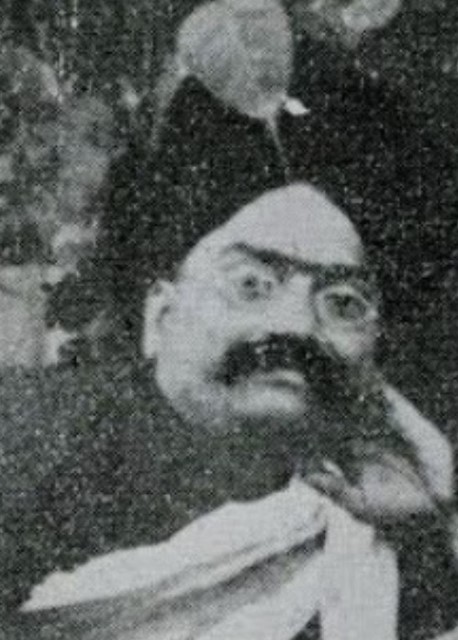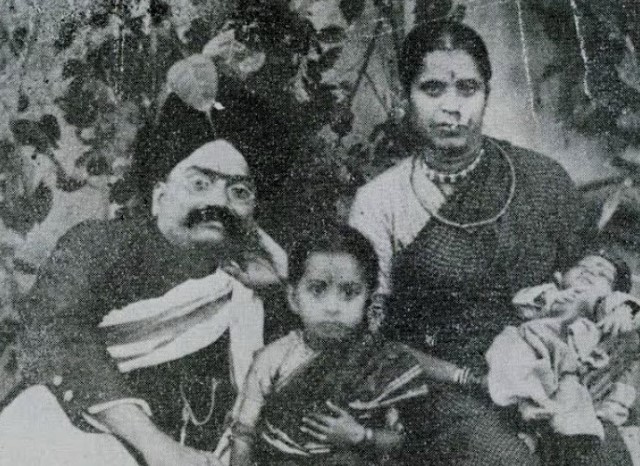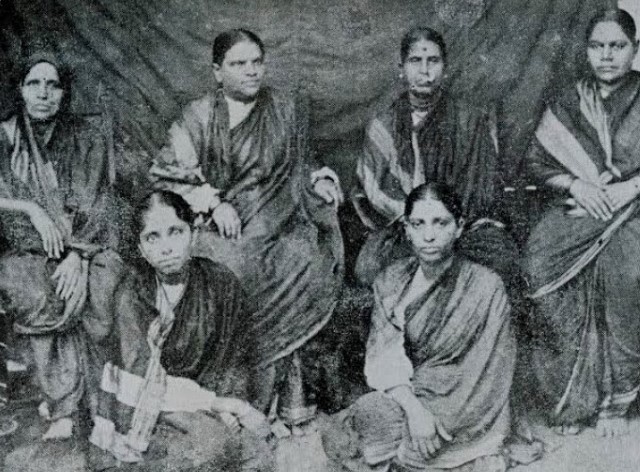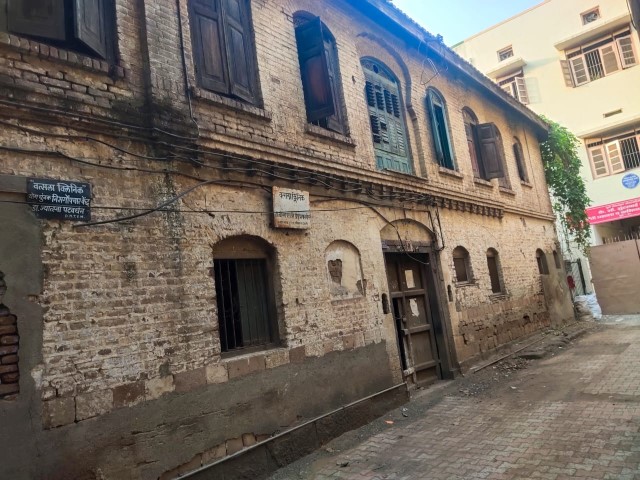|
Sai Mahagbhakte Late Smt.Kashibai Kanitkar's information is mentioned in Chapter 7, Chapter 32 of Holy Shri Sai Satcharitra and also in Shri Sai Sagar, Volume 12, No. 3, Deepavali issue 2012. Kashibai was born on 20th January 1861 (ref: Marathi Vishwakosh), in a wealthy Brahmin family in the town of Ashte in Sangli district. At the age of 9 she was married to Govind Vasudev Kanitker who was 7 years older than her.She had no formal education, but on account of her husband’s encouragement she learned to read and write. Kashibai soon mastered Marathi, Sanskrit and English.Kashibai was a prolific writer and received many accolades for both her fiction and non-fiction novels. She wrote the biography of Dr. Anandibai Joshi, the first lady doctor in India who received her education in the United States. It is read even to this day by scholars and aspiring doctors. Kashibai’s talent was a gift from God, as no other member of her family had that kind of writing skill.
Govind Vasudev Kanitkar
Govind Vasudev Kanitkar & Kashibai Kanitkar Kashibai was fortunate to visit Shirdi numerous times, and Baba loved and respected her a lot. In her autobiography, she has written about her frequent visits to Shirdi. In 1899 her daughter Krishnabai was unwell, as she had had a mishap.The bullock cart in which she was riding overturned and she sustained a head injury. The wound on her scalp failed to heal even after the best possible treatment was given. Following this, she had frequent bouts of headaches, dizziness and numerous other problems. In 1901 Krishnabai returned to Ahmednagar where her in-laws resided, and was treated there. Despite the treatment, her symptoms continued relentlessly. Then Krishnabai got treated in Mumbai, Pune and Alibaug, without any respite. So Kashibai and her family went to Ahmednagar to look after her.
Kashibai Kanitkar family photograph One day Nana Saheb Chandorkar visited them. Nana said, “You have tried all kinds of doctors, taken her for treatment to renowned hospitals, but every modality of treatment has failed. Krishnabai has not improved a smidgen and is getting worse by the day. Now listen to what I have to say. Near Kopergaon there is a village named Shirdi where a wondrous saint called Sai Baba resides. I will give you a little Udi of his which is a ‘cure-all’. This should be applied to her forehead and taken internally. She will definitely be rid of her problems. Thereafter do go and pay your respects to Baba.” Chandorkar then gave a glowing account of Baba’s divinity. However, Krishnabai in-laws and Kashibai’s family didn’t believe in these things, thus they didn’t use the Udi and didn’t go to Shirdi. A short while later, Kashibai’s husband Govind got transferred to Dhule, where they stayed for a year. During this period they had quite forgotten Baba’s name. The Kanitkers then moved to Malegaon, and then to Yevola, where Kashibai heard about Baba from the advocates that came from Ahmednagar to meet her husband. They spoke about Baba’s compassion and divinity, and asked Govind to go and meet him. A few days later she found a picture of Baba lying on the table. No one had given them the picture, nor had anyone sent the picture by post to them. Nevertheless, the thought of going to Shirdi didn’t occur to them. Govind Kanitker then visited Kopergaon on his tour of duty and at that time they all visited Shirdi. Immediately after Govind Kanitker finished his work in Kopergaon, he was transferred to Rahata. As Rahata was the neighbouring village, they frequently visited Shirdi. Kashibai says, “These days where they have the Chavadi procession (South-facing Chavadi), that Chavadi was converted into a kitchen and we cooked our meals there. The Marathi school (now the Sai complex) was where we slept at night.” Kashibai says, “In those days Baba would accept no more than two paise as dakshina. With that money he purchased wood for his Dhuni throughout the day. He always paid the vendor 6 paise for it. Whether the vendor sold him 5 sticks of wood or the trunk of a huge tree, he would be paid no more than 6 paise. No matter how many times the cart came bringing wood, Baba never failed to purchase it, and the wood would be stacked against the rear wall of the Sabha Mandap.”. In her autobiography, she writes about the incident of Baba returning the dakshina to her husband. “Prior to visiting Shirdi I had heard that Baba used the money given as dakshina to purchase fire-wood for his Dhuni. I liked the idea immensely as each devotee would receive a fistful of Udi from his Dhuni.So I had brought a large amount of change (coins) with me. Every day I gave everyone the same denomination of coins to offer to Baba. On the last day I ran out of change so I gave everyone a different denomination of coin to offer. My daughter Banutai came to receive her money and said, ‘Mother why are you giving everyone different coins? Give everyone a coin of the same value.’ I replied, ‘I have run out of coins of the same denomination, and now there is no time to go and get change as it’s getting late. Just give what you have in your hand, and go and sit in the cart. Besides, for the past 4 days didn’t we give the same amount to Baba? That is enough.’ Then my husband and his entourage went to meet Baba. First the sepoy, the bailiff, and other officers went and offered their respects and dakshina. Then my children and other relatives gave dakshina. Following them my husband prostrated at Baba’s feet and gave him dakshina. Then Baba put his hand under the sack that he sat on and took out the money and returned all the money that was offered by the family. Thus my husband got proof of Baba’s omnipresence, but I felt hurt and sad. So I said, ‘Baba don’t you want to buy wood for the Dhuni?’ Then Baba repeated the same words that I had said to my daughter, ‘Didn’t you give me money for the past 4 days? That is enough.’” Thus, Kashibai also got an experience of Baba’s omnipresence. On Kashibai’s first visit to Shirdi while they were travelling from Kopergaon, she thought, “How does one recognise a true saint? I am quite naive about this. And I don’t know anything about this.” Then she remembered when she was young, she along with her parents had gone to Akkalkot. There they met Swami Samarth and paid homage to him. So mentally she decided that if Baba was like Swami Samarth then she would have faith in him. Kashibai and her family then went to the Dwarkamai and prostrated at Baba’s feet. However her eldest son Madhavrao and her son-in-law Gangadhar Panth Dabholkar were late in coming. When they went to the Dwarkamai, Baba had just returned from his bhiksha rounds and was seated near the railing. Just as they ascended the steps of the Dwarkamai, both of them saw Swami Samartha seated there. A short while later they saw Baba seated there. Afterwards they narrated this wonderful experience to her. Thus Kashibai got the answer that she was looking for, though unfortunately she was unable to see this leela (Ref: Shri Sai Sagar, Volume 12, No. 3, Deepavali issue 2012 and Published in Baba's Divine Manifestations by Vinny Chitluri). Smt.Kashibai Kanitkar, resident of Pune, Maharashtra was a learned Woman. She has narrated her experience with Sai in her own words and the same has been published in Shri Sai Leela Magazine Vol. 11, 1934 as follows: - "On hearing of Baba’s miracles, we were discussing according to our theosophical convention and fashion whether Sai Baba belonged to black or white lodge. When once I went to Shirdi, I was thinking seriously about this in my mind. As soon as I approached the steps of the Masjid, Baba came to the front and pointing to His chest and staring at me spoke rather vehemently -"This is a Brahmin, pure Brahmin. He has nothing to do with black things. No Musalman can dare to step in here. He dare not." Again pointing to his chest - "This Brahmin can bring lacks of men on the white path and take them to their destination. This is a Brahmin’s Masjid and I won’t allow any black Mohammedan to cast his shadow here” (Ref: Shri Sai Satcharitra Chapter 7).
Kanitkar Wada, R B Kumthekar Road, Nr. Bharat Woollen House, Sadashiv Peth, Pune One Smt.Gokhale came to Shirdi with an introductory letter from Smt. Kashibai Kanitkar to Dada Kelkar. She came to Baba with a determination to sit at Baba's Feet observing a three days fast. The day previous, Baba said to Dada Kelkar, that He would not allow his children to starve during the Shimga, i.e., Holi holidays, and that if they had to starve, why was He there? Next day when the woman went with Dada Kelkar and sat at Baba's Feet, Baba at once said to her, "Where is the necessity of fasting? Go to Dadabhat's house, prepare the dish of Puran POlis (wheat rotis with gram-flour and jaggery), feed his children and yourself too." Shimga holidays were on. Mrs. Kelkar was then in her menses and there was nobody to cook in Dadabhat's house. So Baba's advice was very timely. Then Mrs. Gokhale had to go to Dadabhat's house and prepare the dish as directed. She cooked that day, fed others and heself. What a good story and how beautiful its import! (Ref: Shri Sai Satcharitra Chapter 32). Once, when Govind V. Kanitker was working in Yevola, he took his family to Shirdi. Prior to their departure from Yevola, Govind had hired a tonga for the to and fro journey from Shirdi. On that visit, Shyama and his children accompanied them to the Dwarka Mai. As soon as Baba saw them, he turned to Govind and said, "Now where do you think you are going? You will go alone from here at 2 a.m". Kashibai realised that they would have to stay that night there. So they stayed in the old Marathi shala. Around midnight an officer from Yevola came to meet Govind, and handed him a telegram. The telegram was from his brother Chintu saying, "Mother is seriously I'll" and asked him to come soon. As Govind had to leave, Kashibai packed his bags for him and he left at 2 a.m., exactly as Baba had said. The next day, Kashibai packed her bags and got ready to leave. When they went to Baba to ask for permission to leave, he refused. So they sat in the Dwarka Mai. Baba said, "Time and again he promised to go and meet her, but procrastinated every single time. Now the telegram has come. Someone is sick, but the Symptoms are present in someone else". Baba literally said,"Who has the ailment, and who has the symptoms No one could understand what Baba was saying or to whom. Kashibai returned to her room, and Baba sent a platter full of burfis so she could break her ekadashi fast with them. When the Kanitkers returned to the Dwarka Mai, Baba was getting ready to prepare some shira. Baba said, "Would anyone like to eat shira?" Immediately, the thought cropped up in Kashibai's mind, "How to eat the shira prepared by a Muslim?". Concurrently Baba put both his hands over his ears and said, "Arre! I am not trying to desecrate or defile anyone's religious beliefs. It is good, and if anyone desires to eat the shira they may do so". Then Baba got up and washed the plates, wiped them, and filled the plates with piping hot shira from His Handi. Thereafter Kashibai's sister and other family members, including her children, started eating the shira. After a while, Kashibai requested Baba for permission to leave, but he was silent. At that moment Dada Kelkar came to the Dwarka Mai. Pointing to Kashibai, Baba said, "She is my mother, and has come here from far away. She has observed the fast for ekadashi, so, she and her family are hungry. Can't you prepare some bhakri and feed her and the children? Thus your Soul will be satisfied". Hearing this, Dada Kelkar requested them to join him for lunch. That day Kashibai received a leter from her husband saying that his mother was alright. However, his sister Gangu had severe iabour pains, and had delivered a baby girl that night. Then Kashibai understood why Baba had said, "Someone is Sick, but the symptoms are present in someone else. In 1906, the Kanitkers visited Shirdi again. On that occasion, Baba had wrapped his finger with a dirty, oily strip of cloth. Kashibai mentaliy wondered what had happened to Baba's finger. Simutaneousiy Baba said. "My finger got burnt, so I bandaged it". And he unwrapped the bandage and showed her his fnger that had turned whitish in colour. Later she heard that Madhavnath Maharaj of Nasik had burnt his finger and Baba hac taken the burns upon himself. On that visit, the villagers claimed that there was a rabid dog in Shirdi, and they tried to kill i it with steel rods and sticks. They chased it around the village, until finally the dog took refuge in the Dwarka Mai and sat behind Baba. The villagers cautioned Baba saying, "Baba, don't touch that dog: it is rabid and will bite you." Baba angrily drove the villagers away. The dog rested behind Baba for a short while and went away. Thereafter, it freely roamed about without any symptoms of rabies; nor did it attack or bite anyone. (Ref.: Shri Sai Sagar, Volume 12, No. 3, Deepavali issue, 2012). Smt.Kashibai Kanitkar passed away on 30th January 1948 (ref: Marathi Vishwakosh). (Source: Holy Shri Sai Satcharitra Chapter 7 and Chapter 32, Shri Sai Sagar, Volume 12, No. 3, Deepavali issue 2012 and published in Baba's Divine Manifestations by Vinny Chitluri. Photo Courtesy: Shri.Jignesh C.Rajput, Surat) |




